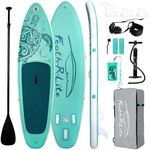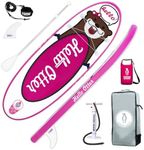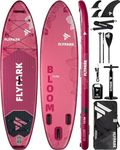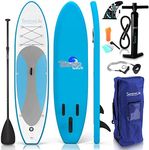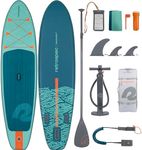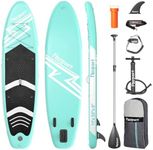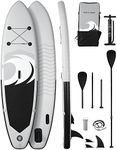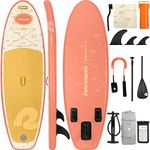Buying Guide for the Best Paddleboard For Kids
Choosing a paddleboard for kids is all about finding the right balance between safety, ease of use, and fun. Kids need boards that are stable, lightweight, and easy to handle both on and off the water. When shopping, focus on features that make the experience enjoyable and safe for young paddlers, and always consider the child's age, size, and skill level. Understanding the key specifications will help you make a confident choice that matches your child's needs and encourages them to enjoy paddleboarding.Board LengthBoard length refers to how long the paddleboard is from tip to tail. For kids, shorter boards (typically between 7 to 9 feet) are easier to control and maneuver, making them ideal for younger or smaller children. Medium lengths (around 9 to 10 feet) can suit older kids or those who are more experienced. Longer boards are generally not recommended for kids as they can be harder to handle. To pick the right length, consider your child's age, height, and paddling experience—smaller, less experienced kids will do best with shorter boards.
Board WidthBoard width is the measurement across the board at its widest point. Wider boards (around 28 to 32 inches) offer more stability, which is important for kids who are still learning to balance. Narrower boards are faster but less stable, and are better suited for older or more skilled paddlers. For most kids, a wider board is the safest and most confidence-boosting choice, especially for beginners.
Board ThicknessThickness affects both the board's buoyancy and how stable it feels on the water. Thicker boards (about 4 to 6 inches) float better and are more stable, which is great for kids. Thinner boards may feel less steady and are usually not necessary for young paddlers. When choosing, look for a board with enough thickness to support your child's weight comfortably, ensuring they stay above the water and feel secure.
Weight CapacityWeight capacity tells you the maximum weight the board can safely support. It's important to choose a board with a weight limit that matches or slightly exceeds your child's weight, including any gear they might bring. Boards with too high a capacity may be harder for small kids to control, while boards with too low a capacity may not float properly. Always check this spec to ensure safety and performance.
Board WeightBoard weight is how heavy the paddleboard is when you carry it. Lighter boards are easier for kids to move, carry, and handle both on land and in the water. Heavier boards can be difficult for children to manage, especially if they need to transport it themselves. When picking, think about whether your child will be carrying the board alone or with help, and choose a weight that matches their strength and independence.
MaterialPaddleboards are made from different materials, such as inflatable PVC or solid foam/plastic. Inflatable boards are lightweight, easy to store, and soft if kids fall on them, making them a popular choice for children. Solid boards are more rigid and can offer better performance, but they are heavier and harder to transport. Consider how and where the board will be used—if you need something portable and safe for play, inflatable is often best for kids.
Deck PadThe deck pad is the soft, grippy surface on top of the board where kids stand. A good deck pad provides comfort and helps prevent slipping, which is important for safety. Look for boards with a large, textured deck pad that covers most of the standing area. This is especially helpful for beginners who may move around a lot on the board.
Fin SetupFins help the paddleboard go straight and provide stability. Some boards have a single large fin, while others have two or three smaller fins. For kids, a simple fin setup (like a single or three small fins) is usually easiest to manage and provides enough stability for learning. Removable fins can be helpful for storage and transport. Choose a setup that matches your child's skill level and the type of water they'll be paddling in.

